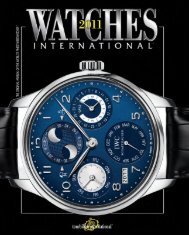- Page 3 and 4:
the original annual of the world’
- Page 5:
PIAGET EMPERADOR COUSSIN Piaget Man
- Page 9 and 10:
PIAGET EMPERADOR Piaget Manufacture
- Page 11 and 12:
NEW YORK, NEW YORK A New York City
- Page 13 and 14:
HANDLE WITH CARE To maintain the be
- Page 15 and 16:
www.chanel.com
- Page 17 and 18:
WK RI 6HSWHPEHU ,Q WKH RIILFHV RI W
- Page 19 and 20:
CALIBER RM 017 EXTRA FLAT TOURBILLO
- Page 21 and 22:
The future’s safe. IWC. The futur
- Page 23 and 24:
21 •
- Page 25 and 26:
Time Space Quantième Perpétuel (G
- Page 27 and 28:
UNICO GOLD ! "& '. ) "* +! ")*+ '$,
- Page 30 and 31:
• 28 Grand Complications, Vol. VI
- Page 32 and 33:
• From day one, Westime has also
- Page 34 and 35:
• Summary Letter from the Preside
- Page 36 and 37:
ONLY ONE WATCH MANUFACTURE Our coll
- Page 38 and 39:
• Web Site Directory A. LAnge & S
- Page 40:
BR INSTRUMENT MINUTEUR TOURBILLON .
- Page 43:
www.jacobandco.com 4(%15%.44). 2EVO
- Page 47 and 48:
HERITAGE IN THE MAKING WWW.PARMIGIA
- Page 50:
Index IWC SChAFFAUSen AQUATIMER AUT
- Page 53 and 54:
Limited Edition of 177 pieces www.d
- Page 55 and 56:
EXCALIBUR RD01SQ - SKELETON DOUBLE
- Page 57 and 58:
Over the years, Longines has dedica
- Page 59 and 60:
REPETITION MINUTE © =(3+
- Page 61 and 62:
ClOSe-up On Calendar WaTCHeS Hours,
- Page 63 and 64:
It was on this double month-and-yea
- Page 65 and 66:
They were divided into three ten-da
- Page 67 and 68:
how does it work? The simple calend
- Page 69 and 70:
10 6 8 10. iwC, Portuguese Tourbill
- Page 71 and 72:
7 4 5 8 6 6. Jaquet droz, Grande Da
- Page 73 and 74:
1. rolex, Oyster Perpetual Day-Date
- Page 75 and 76:
1. Girard-Perregaux, Vintage 1945 S
- Page 77 and 78:
1 1. iwC, Da Vinci Perpetual Calend
- Page 79 and 80:
6 Calendars 77 •
- Page 81 and 82:
4 5 1. vacheron Constantin, Patrimo
- Page 83 and 84:
6. de Grisogono, Instrumento Novant
- Page 85 and 86:
2 Calendars 83 •
- Page 87 and 88:
A. LANGE & SÖHNE LANGEMATIK PERPET
- Page 89 and 90:
BLANCPAIN L-EVOLUTION SEMAINIER GRA
- Page 91 and 92:
GLASHÜTTE ORIGINAL SENATOR PERPETU
- Page 93 and 94:
GUY ELLIA TIME SPAcE QUANTIEME PERP
- Page 95 and 96:
IWc ScHAFFHAUSEN DA VINcI PERPETUAL
- Page 97 and 98:
IWc ScHAFFHAUSEN PORTUGUESE PERPETU
- Page 99 and 100:
PATEK PHILIPPE ANNUAL cALENDAR cHRO
- Page 101 and 102:
PIAGET PIAGET EMPERADOR cOUSSIN - R
- Page 103 and 104:
ROGER DUBUIS EXcALIBUR PERPETUAL cA
- Page 105 and 106:
ULYSSE NARDIN EL TORO - REF. 322-00
- Page 107 and 108:
VAcHERON cONSTANTIN PATRIMONY TRADI
- Page 109 and 110:
ZENITH AcADEMY QUANTIEME PERPETUEL
- Page 111 and 112:
For watchmaking purists, a “compl
- Page 113 and 114:
ECOrd-BrEAkInG pOCkET-wATCHES If th
- Page 115 and 116:
This complications record was beste
- Page 117 and 118:
A USEFUl Or prACTICAl COMplICATIOn
- Page 119 and 120:
A. LANGE & SÖHNE SAXoNIA ANNUAL CA
- Page 121 and 122:
BLANCPAIN L-EVOLUTION TOURBILLON GM
- Page 123 and 124:
FRANCK MULLER TOURBILLON 9850 EVOLU
- Page 125 and 126:
HARRY WINStoN MIDNIGHt CHRoNo toURB
- Page 127 and 128:
HUBLot LA CLE DU tEMpS - REF. Mp-02
- Page 129 and 130:
JAEGER-LeCoULtRE AMVoX3 toURBILLoN
- Page 131 and 132:
JAEGER-LeCoULtRE HYBRIS MECHANICA R
- Page 133 and 134:
JAEGER-LeCoULtRE MAStER GRANDE tRAD
- Page 135 and 136:
pARMIGIANI tECNICA CHRoNo - REF. pF
- Page 137 and 138:
ULYSSE NARDIN “GENGHIS KHAN HAUtE
- Page 139 and 140:
ULYSSE NARDIN pLANEt EARtH - REF. 9
- Page 141 and 142:
VACHERoN CoNStANtIN pAtRIMoNY tRADI
- Page 143 and 144:
VACHERoN CoNStANtIN pAtRIMoNY tRADI
- Page 145 and 146:
VACHERoN CoNStANtIN QUAI DE L’ILE
- Page 147 and 148:
The tourbillon is one of Abraham-Lo
- Page 149 and 150:
“Haute horology must open up to t
- Page 151 and 152:
Are you planning to work with other
- Page 153 and 154:
Tourbillons 151 •
- Page 155 and 156:
But you’ve announced the opening
- Page 157 and 158:
Bell & Ross CEO Carlos Rosillo says
- Page 159 and 160:
“I’m sure there are some who as
- Page 161 and 162:
What was your professional backgrou
- Page 163 and 164:
How far have you progressed in the
- Page 165 and 166:
Richard Mille, RM 017 Extra Flat To
- Page 167 and 168:
THE TOURBILLON CRAzE Since the turn
- Page 169 and 170:
FLOATING ISLAND Other brands go eve
- Page 171 and 172:
Breguet, Marine Tourbillon Chronogr
- Page 173 and 174:
On the Tourbillon 24 Seconds Inclin
- Page 175 and 176:
A FLURRY OF TOURBILLONS Another tec
- Page 177 and 178:
Tourbillons 175 •
- Page 179 and 180:
AUDEMARS PIGUET JULES AUDEMARS MINU
- Page 181 and 182:
BELL & ROSS BR 01 INSTRUMENT TOURBI
- Page 183 and 184:
BELL & ROSS BR 01 INSTRUMENT TOURBI
- Page 185 and 186:
BELL & ROSS INSTRUMENT BR MINUTEUR
- Page 187 and 188:
BREGUET FUSEE TOURBILLON - REF. 704
- Page 189 and 190:
BVLGARI TOURBILLON LUMIERE - REF. B
- Page 191 and 192:
CHANEL J12 RETROGRADE MYSTERIEUSE -
- Page 193 and 194:
DEWITT TWENTY-8-EIGHT REGULATOR A.S
- Page 195 and 196:
FRANCK MULLER TOURBILLON CURVEX POW
- Page 197 and 198:
FRéDéRIQUE CONSTANT TOURBILLON MA
- Page 199 and 200:
GUY ELLIA TOURBILLON ZEPHYR With a
- Page 201 and 202:
GUY ELLIA TOURBILLON MAGISTERE II G
- Page 203 and 204:
HUBLOT KING GOLD CERAMIC TOURBILLON
- Page 205 and 206:
IWC SCHAFFHAUSEN PORTUGUESE TOURBIL
- Page 207 and 208:
JACOB & CO CRYSTAL TOURBILLON - REF
- Page 209 and 210:
JACOB & CO RAINBOW TOURBILLON - REF
- Page 211 and 212:
JAEGER-LeCOULTRE MASTER TOURBILLON
- Page 213 and 214:
PANERAI RADIOMIR TOURBILLON GMT - R
- Page 215 and 216:
PARMIGIANI KALPA XL TOURBILLON - RE
- Page 217 and 218:
PARMIGIANI TONDA 42 TOURBILLON - RE
- Page 219 and 220:
PIAGET ALTIPLANO TOURBILLON GOUSSET
- Page 221 and 222:
PIAGET PIAGET EMPERADOR SKELETON TO
- Page 223 and 224:
PIAGET PIAGET EMPERADOR TOURBILLON
- Page 225 and 226:
PIAGET PIAGET POLO TOURBILLON RELAT
- Page 227 and 228:
PIAGET PIAGET POLO TOURBILLON RELAT
- Page 229 and 230:
REBELLION REB-5 TOURBILLON ROSE GOL
- Page 231 and 232:
RICHARD MILLE RM 020 TOURBILLON POC
- Page 233 and 234:
RICHARD MILLE RM 026 TOURBILLON The
- Page 235 and 236:
ROGER DUBUIS EXCALIBUR AUTOMATIC TO
- Page 237 and 238:
STÜHRLING ORIGINAL APOCALYPSE REVE
- Page 239 and 240:
ULYSSE NARDIN FREAK DIAVOLO - REF.
- Page 241 and 242:
ULYSSE NARDIN ROYAL BLUE - REF. 799
- Page 243 and 244:
VACHERON CONSTANTIN MALTE TOURBILLO
- Page 245 and 246:
ZENITH EL PRIMERO TOURBILLON - REF.
- Page 247 and 248:
While the striking mechanism is the
- Page 249 and 250:
CoMMeMoRaTIVe WaTCHeS 1969 also saw
- Page 251 and 252:
Chopard has recently unveiled a col
- Page 253 and 254:
Montblanc, Nicolas Rieussec Open Da
- Page 255 and 256:
SINGLe CouNTeRS IN THe LIMeLIGHT In
- Page 257 and 258:
6 H>C;JC8I>DC EJH=:G L]^aZ dc i]Z i
- Page 259 and 260:
Chronographs, Split-Seconds and fly
- Page 261 and 262:
The brand from Saxony, Germany has
- Page 263 and 264:
and speaking of countdowns, the Ger
- Page 265 and 266:
A. LANGE & SÖHNE dOUbLE SPLit - RE
- Page 267 and 268:
AUdEMARS PiGUEt ROyAL OAk OFFSHORE
- Page 269 and 270:
VLGARi OCtO CHRONOGRAPHE QUAdRi-REt
- Page 271 and 272:
GLASHÜttE ORiGiNAL SENAtOR RAttRAP
- Page 273 and 274:
HARRy WiNStON OCEAN tRiPLE REtROGRA
- Page 275 and 276:
iWC SCHAFFHAUSEN dA ViNCi CHRONOGRA
- Page 277 and 278:
iWC SCHAFFHAUSEN PiLOt’S WAtCH CH
- Page 279 and 280:
iWC SCHAFFHAUSEN PORtUGUESE yACHt C
- Page 281 and 282:
JAEGER-LeCOULtRE dUOMEtRE A CHRONOG
- Page 283 and 284:
LONGiNES tHE LONGiNES COLUMN-WHEEL
- Page 285 and 286:
PANERAi LUMiNOR 1950 8 dAyS RAttRAP
- Page 287 and 288:
PANERAi LUMiNOR 1950 RAttRAPANtE, 4
- Page 289 and 290:
PANERAi RAdiOMiR CHRONOGRAPH - REF.
- Page 291 and 292:
PAtEk PHiLiPPE SPLit-SECONdS CHRONO
- Page 293 and 294:
PiAGEt LiMELiGHt EXCEPtiONAL PiECE
- Page 295 and 296:
PiAGEt PiAGEt POLO CHRONOGRAPH iN P
- Page 297 and 298:
PiAGEt PiAGEt POLO FORtyFiVE - REF.
- Page 299 and 300:
RiCHARd MiLLE RM 025 tOURbiLLON CHR
- Page 301 and 302:
tAG HEUER 1916: tHE MikROGRAPH The
- Page 303 and 304:
tAG HEUER 1965: CARRERA dAtE 45 Aft
- Page 305 and 306:
tAG HEUER 2006: tHE CARRERA CALibRE
- Page 307 and 308:
tAG HEUER 2007: GRANd CARRERA CALib
- Page 309 and 310:
tAG HEUER 2010: tAG HEUER MONACO V4
- Page 311 and 312:
tAG HEUER 2011: tAG HEUER CARRERA M
- Page 313 and 314:
ULySSE NARdiN MAXi MARiNE CHRONOGRA
- Page 315 and 316:
ULySSE NARdiN MAXi MARiNE diVER CHR
- Page 317 and 318:
VACHERON CONStANtiN OVERSEAS CHRONO
- Page 319 and 320:
zENitH EL PRiMERO RAttRAPANtE - REF
- Page 321 and 322:
Before time was divided into 24 tim
- Page 323 and 324:
“We are convinced that there is a
- Page 325 and 326:
The pure dial adorned with a vertic
- Page 327 and 328:
Jaeger-LeCoultre, Reverso Squadra W
- Page 329 and 330:
POINTER-TyPE SySTEM The simplest wa
- Page 331 and 332:
Another potential choice is to disp
- Page 333 and 334:
DISCS AND WINDOWS Multiple time zon
- Page 335 and 336:
AND TIME BECAME UNIVERSAL In 1936,
- Page 337 and 338:
AUDEMARS pIGUET JULES AUDEMARS DUAL
- Page 339 and 340:
BVLGARI DIAGONO X-pRO - REF. Dp45BS
- Page 341 and 342:
de GRISOGONO FUSO QUADRATO N°2 CLO
- Page 343 and 344:
de GRISOGONO MECCANICO ROSE GOLD de
- Page 345 and 346:
DEWITT THE TRIpLE COMpLICATION-GMT
- Page 347 and 348:
HARRY WINSTON OCEAN TOURBILLON GMT
- Page 349 and 350:
pANERAI LUMINOR 1950 8 DAYS GMT - R
- Page 351 and 352:
pIAGET pIAGET ALTIpLANO DOUBLE JEU
- Page 353 and 354:
pIAGET pIAGET EMpERADOR COUSSIN pER
- Page 355 and 356:
RICHARD MILLE RM 022 TOURBILLON AER
- Page 357 and 358:
ULYSSE NARDIN DUAL TIME - REF. 243-
- Page 359 and 360:
ULYSSE NARDIN EXECUTIVE DUAL TIME -
- Page 361 and 362:
ULYSSE NARDIN EXECUTIVE LADY - REF.
- Page 363 and 364:
VACHERON CONSTANTIN MALTE DUAL TIME
- Page 365 and 366:
VACHERON CONSTANTIN OVERSEAS DUAL T
- Page 367 and 368:
The choice of the direction in whic
- Page 369 and 370:
“We are the very opposite of a fa
- Page 371 and 372: What is your target clientele? Chan
- Page 373 and 374: Chanel, J12 Retrograde Mysterieuse
- Page 375 and 376: A STUNNING VISION The dance of the
- Page 377 and 378: 6
- Page 379 and 380: For the Opus 8 by Harry Winston, Fr
- Page 381 and 382: A>C:6G 9>HEA6NH I]Z aViZhi igZcY! X
- Page 383 and 384: AUdEMARS pIGUET jULES AUdEMARS SKEL
- Page 385 and 386: BVLGARI OcTO BI-RETRO - REF. BGO43B
- Page 387 and 388: cHANEL j12 RETROGRAdE MYSTERIEUSE -
- Page 389 and 390: LONGINES THE LONGINES MASTER cOLLEc
- Page 391 and 392: pIAGET pIAGET EMpERAdOR cOUSSIN pER
- Page 393 and 394: pIAGET pIAGET REcTANGLE A L’ANcIE
- Page 395 and 396: ROGER DUBUIS EXCALIBUR DOUBLE TOURB
- Page 397 and 398: VAcHERON cONSTANTIN pATRIMONY cONTE
- Page 399 and 400: Human time is not the same as that
- Page 401 and 402: Never-eNdiNg story the equation of
- Page 403 and 404: 6jYZbVgh E^\jZi Vahd X]dhZ id ^cY^X
- Page 405 and 406: Equations of Time 403 •
- Page 407 and 408: BLANCPAIN VILLERET EQUATION MARCHAN
- Page 409 and 410: PANERAI LUMINOR 1950 EQUATION OF TI
- Page 411 and 412: The audible indication of the time
- Page 413 and 414: “The watch industry is experienci
- Page 415 and 416: How about Jaquet Droz, which you ar
- Page 417 and 418: Christophe Claret CEO of Christophe
- Page 419 and 420: =dlZkZg! ^c jckZ^a^c\ ]^h ]dgdad\^X
- Page 421: Guy Ellia, Répétition Minute Zeph
- Page 425 and 426: The Challenge RMT-S by the Geneva-b
- Page 427 and 428: I]^h ineZ d[ Y^heaVn ^h eVgi^XjaVga
- Page 429 and 430: THE ULTIMATE SOUND EXPERIENCE Undou
- Page 431 and 432: Finally, an all too rare phenomenon
- Page 433 and 434: AudEMARS pIGuET MILLENARY HANd-WouN
- Page 435 and 436: BLANCPAIN CARROUSEL REPETITION MINU
- Page 437 and 438: BVLGARI oCTo REpETITIoN MINuTES RET
- Page 439 and 440: de GRISoGoNo oCCHIo RIpETIZIoNE MIN
- Page 441 and 442: de GRISoGoNo oCCHIo RIpETIZIoNE MIN
- Page 443 and 444: GuY ELLIA REpETITIoN MINuTE ZEpHYR
- Page 445 and 446: IWC SCHAFFHAuSEN poRTuGuESE MINuTE
- Page 447 and 448: pARMIGIANI ToRIC QuAESToR SKELEToN
- Page 449 and 450: uLYSSE NARdIN CIRCuS - REF. 740-88
- Page 451 and 452: uLYSSE NARdIN GENGHIS KHAN - REF. 7
- Page 453 and 454: uLYSSE NARdIN SAFARI - REF. 729-61
- Page 455 and 456: The moonphase is doubtless the most
- Page 457 and 458: A wINDow oN ThE STARS In western ci
- Page 459 and 460: MooNSTRuCk Another notable current
- Page 461 and 462: A STARRING RoLE Alongside apertures
- Page 463 and 464: =# BdhZg 8^Z ! BdhZg EZgeZijVa Bddc
- Page 465 and 466: BVLGARI GRANDE LUNE - REF. BRRP46C1
- Page 467 and 468: HARRY WINSTON LADY Z - REF. 400/UAM
- Page 469 and 470: PIAGET PIAGET EMPERADOR COUSSIN MOO
- Page 471 and 472: VACHERON CONSTANTIN KALLA LUNE - RE
- Page 473 and 474:
VACHERON CONSTANTIN TOLEDO 1952 - R
- Page 475 and 476:
Since the development of nautical s
- Page 477 and 478:
AN oySTER oN ThE WRIST Rolex named
- Page 479 and 480:
Its 2010 version is housed in a DLC
- Page 481 and 482:
6bdc\ Y^kZghÉ lViX]Zh! i]ZgZ VgZ b
- Page 483 and 484:
Luminox, Deep Dive Diving 481 •
- Page 485 and 486:
HARRY WInSTOn OCEAn DIVER - REF. 41
- Page 487 and 488:
IWC SCHAFFHAUSEn AQUATIMER DEEP TWO
- Page 489 and 490:
PAnERAI LUMInOR 1950 SUBMERSIBLE DE
- Page 491 and 492:
ZEnITH DEFY XTREME SEA OPEn Cased i
- Page 493 and 494:
Measuring the passing of time is no
- Page 495 and 496:
Alarms 493 •
- Page 497 and 498:
sTrIkInG InnoVATIons Jaeger-leCoult
- Page 499 and 500:
since then other brands have follow
- Page 501 and 502:
UnDerWATer soUnDs We are also seein
- Page 503 and 504:
BREGUET REVEIL MUsICAL - REF. 7800B
- Page 505 and 506:
JAEGER-LeCOULTRE MAsTER MEMOVOX INT
















